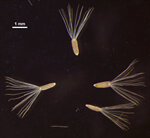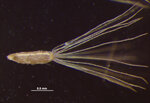Taxonomy
Conyza canadensis (L.) Cronquist, Bull. Torrey Bot. Club 70: 632. 1943.Common synonyms
Erigeron canadensis L. Sp. Pl. 2: 863. 1753; Leptilon canadense (L.) Britton Ill. Fl. N. U.S. (Britton & Brown) 3: 391. 1898; Marsea canadensis (L.) V.M.Badillo Bol. Soc. Venez. Ci. Nat. 10: 256. 1946; Aster canadensis (L.) E.H.L.Krause Deutschl. Fl. (Sturm), ed. 2. 13: 59, pl. 10. 1905.
Conyza is not distinct from Erigeron, and the name cited here as a synonym would be more scientifically correct. The species is retained here as a Conyza merely to avoid confusion.
Common name
Canadian fleabane, horseweed
Description
Propagule or dispersal unit is the fruit with pappus. Fertile part 0.9-1.2 mm long, 0.2-0.5 mm wide, in side view widest in upper part (obovoid) or widest in the middle, +/- straight, the upper (apical) end narrowing, in cross-section flattened, basal scar (carpopodium) pronounced and well-differentiated, central, beak (=thinner sterile stalk between seed and pappus) absent, wings absent, fruit surface light brown or straw, smooth (except at cellular level), with simple straight hairs, thickened margin absent or present (by misinterpretation), thick margin hairs simple straight hairs, longitudinal ribs absent or present, 2, their surfaces smooth, with simple straight hairs.
Pappus type bristles / hairs, pappus elements all +/- similar, up to 1.8-3 mm long, in one row, pappus elements numerous, persistent or elements falling off individually, the individual bristles rough / serrated (barbellate), +/- equal width along length, white / translucent.
Notes: The key accommodates the interpretation of surface structures either as two longitudinal ribs or as a thickened margin. Unfortunately, the fruits of the various species of Erigeron / Conyza are all rather similar and hard to differentiate. Erigeron generally has an additional longitudinal rib on the fruit surface whereas Conyza generally has only the two marginal ribs or thickened margins, depending on interpretation. Among the Conyza, C. canadensis has the smallest fruits at only c. 1 mm length of the fertile part and only up to 3 mm pappus length, but there is some overlap with the other species.
Ecology
Annual herb, fruit wind-dispersed. Temperate, subtropical to higher elevation tropical regions. Weed of agriculture and forestry, roadsides, fallow, disturbed areas.
Native range
Canada, United States
Introduced range
Cosmopolitan.
Past interceptions (Australia): origins
United States, China, Japan.
Unidentified species of the same genus from United States, Mexico, Colombia, Ecuador, Argentina, United Kingdom, Spain, Belgium, France, Germany, Italy, Hungary, Slovakia, Kenya, UAE, India, China, Korea, Japan, Thailand, Indonesia, Papua New Guinea, New Zealand.
Past interceptions (Australia): commodities
New vehicles, cut flowers, containers, fresh fruit.
Unidentified species of the same genus in/on machinery and parts, agricultural machinery, timber pallets, containers, nursery stock, new vehicles, cut flowers, steel, fresh fruit.


